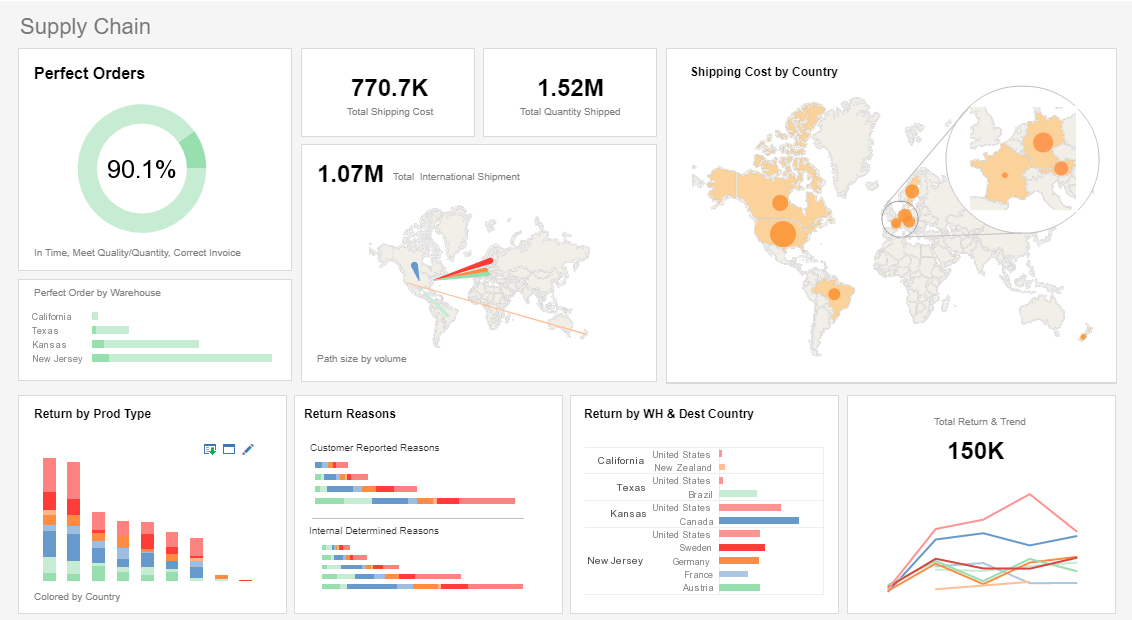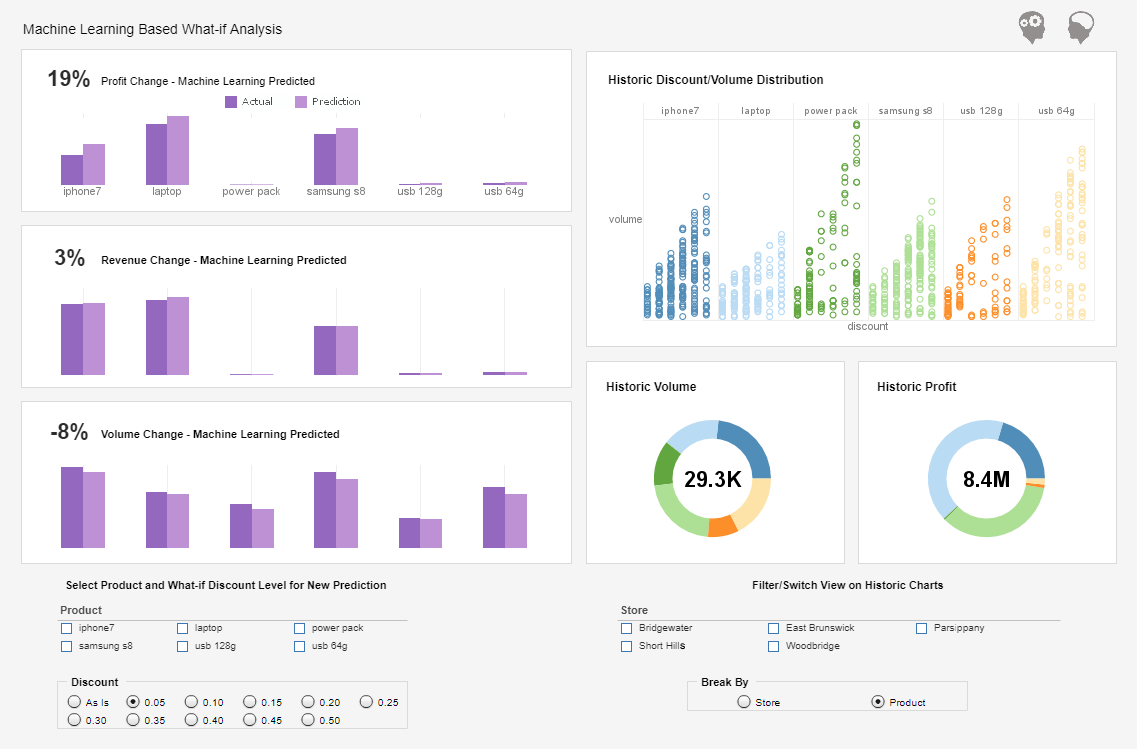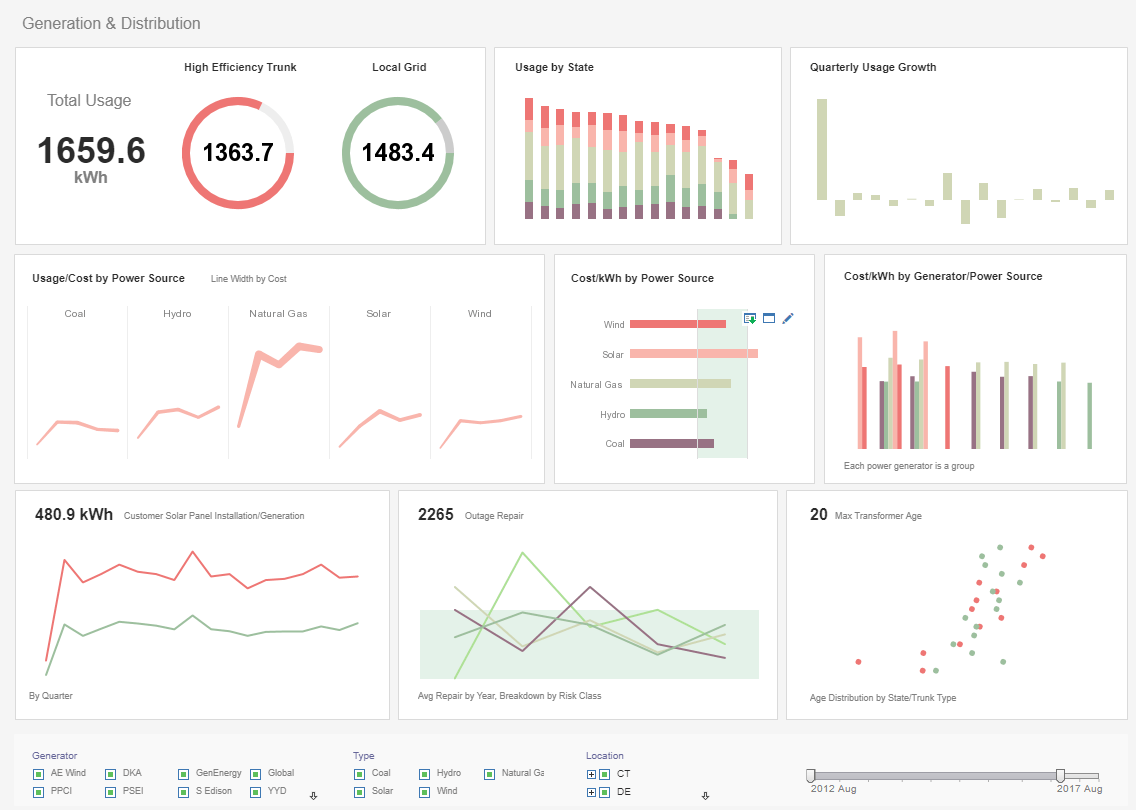Understanding Operations Dashboards
Operations dashboards exist to manage the day-to-day occurrences in a business. They are a particularly good tool when looking at metrics that change frequently and for being able to drill into the details to understand root causes of what is happening.
As the name suggests, operations dashboards paint a picture of business operations. They concern themselves with the here-and-now rather than the later. Analytical dashboards concern themselves with the future.
Why Should You Consider an Operations Dashboard?
If you are interested in how well your KPIs are operating you may want to consider an operations dashboard.
Time sensitive matters, as well, are best analyzed on this way, due to their here-and-now approach. Who is going to be using this dashboard? The overall feel of the dashboard will be determined based on the end user.
Operations dashboards are very well suited to managers and standard business users who are concerned with the current state of a business, rather than executives who must concern themselves with the future.
What are you hoping to achieve by utilizing a dashboard? Use an operational dashboard to track current performance against goals and expose weaknesses to be addressed. See what is working for you and determine best practices.
Finally, an important thing to consider is where your business has its source data stored. Operations dashboards are typically more suited to improving the visibility of singular a system or application as opposed to that of multiple data sources.
How Are Operations Dashboards Different from Other Departmental Dashboards?
In the world of business intelligence and data visualization, dashboards serve as indispensable tools for summarizing performance, identifying issues, and driving decisions. While every department—whether sales, finance, marketing, HR, or IT—relies on dashboards, operations dashboards stand apart in their purpose, structure, and function. This article explores what makes operations dashboards unique, why they matter, and how they differ from other departmental dashboards in scope, design, and usage.
1. Real-Time Emphasis and Temporal Sensitivity
Operations dashboards typically emphasize real-time data or near-real-time refresh cycles. Because operations often involve logistics, manufacturing, service delivery, or resource management, real-time updates are crucial to making timely decisions. In contrast, dashboards in departments like finance or HR may rely more on weekly or monthly aggregated data, as those areas do not require minute-by-minute awareness.
For instance, a manufacturing plant might use an operations dashboard to monitor equipment uptime, inventory levels, or product defect rates. If downtime spikes or a production bottleneck emerges, immediate intervention is necessary. Finance teams, on the other hand, can afford to review their dashboards on a monthly cadence, as their KPIs are often based on closing periods or fiscal quarters.
2. Operational KPIs Are Often Process-Oriented
While departmental dashboards typically track strategic outcomes, operations dashboards focus on process-centric metrics. Key performance indicators (KPIs) in operations are directly tied to workflows, output, and efficiency. Examples include cycle time, lead time, throughput, utilization rate, defect rates, and on-time delivery percentage.
This contrasts with marketing dashboards, which may focus on customer engagement, conversion rates, or campaign ROI—metrics that reflect outcomes but not internal process steps. Operations dashboards are more concerned with how things are done and how efficiently they are executed, making them vital for process improvement and lean initiatives.
3. Multisource and Cross-Functional Integration
Operations dashboards often require integration across multiple systems and departments to provide a unified view. For example, a logistics dashboard might pull data from a warehouse management system (WMS), transportation management system (TMS), ERP, and external GPS tracking services.
In contrast, dashboards for HR or sales may depend on a more limited data set sourced from a single platform like an HRIS or CRM, respectively. The multisource nature of operations dashboards makes them technically more complex to develop and maintain but also more critical for providing a complete operational picture across organizational silos.
4. Focus on Immediate Action and Exception Management
Unlike other departments that use dashboards for historical analysis or strategic planning, operations teams use dashboards for real-time monitoring and incident response. A good operations dashboard acts as a control panel, highlighting variances, exceptions, or anomalies that require swift action.
These dashboards often include alert thresholds, visual indicators such as red/yellow/green signals, and drill-down capabilities to investigate issues quickly. For instance, if a service center sees an unusual spike in unresolved tickets or increased average resolution time, the dashboard should not only flag the problem but help isolate its cause. Sales or HR dashboards rarely carry this kind of urgency in their design.
5. Physical Asset and Human Resource Monitoring
Operations dashboards are unique in that they often monitor physical assets (machinery, vehicles, facilities) as well as human resource deployment. They help managers understand how well machines are functioning, how workforces are distributed, and where bottlenecks might be occurring in physical or digital workflows.
This stands in contrast with dashboards from departments like finance or IT, which are more abstract and number-driven. While IT dashboards may track infrastructure performance, they are not as tied to real-world physical processes as operations dashboards, which must account for constraints like equipment maintenance schedules, shift overlaps, and geographic distribution.
6. Visual Design Tailored for Fast Interpretation
Because operations teams may need to make quick decisions, the visual design of their dashboards is often optimized for instant interpretation. Metrics are displayed in large, legible formats; charts emphasize trends or thresholds; and layout prioritizes spatial awareness of the production floor, supply chain routes, or workload queues.
This contrasts with executive dashboards or HR dashboards that might emphasize clean, summarized visuals for presentation purposes. The operational dashboard is not about impressing stakeholders—it's about giving frontline managers the insights they need to keep the business running smoothly.
7. Alignment with Lean and Continuous Improvement
Operations dashboards are essential tools for driving lean management and Six Sigma methodologies. These frameworks emphasize waste reduction, quality control, and continuous improvement, all of which require detailed and consistent monitoring of process metrics.
As such, operational dashboards often include Pareto charts, root cause analysis tools, and time-based views that allow for the identification of trends and inefficiencies. Dashboards in other departments may not be so tightly linked to such structured methodologies, focusing more on performance summaries than process diagnostics.
8. Greater Customization and Localization
Operational environments can vary significantly—even within the same company—based on plant layout, team roles, or supply chain stages. Therefore, operations dashboards often need to be highly customizable and even localized to specific sites, teams, or shifts.
Compare this to a corporate finance dashboard that can likely serve all stakeholders equally across the enterprise. The operations dashboard must reflect the on-the-ground reality of specific processes, making it more granular and tailored than most other departmental dashboards.
9. Broader User Spectrum
Operations dashboards often serve a wider and more diverse group of users, including supervisors, machine operators, quality inspectors, logistics coordinators, and plant managers. These users may have different technical capabilities and data literacy levels.
As a result, operations dashboards must strike a careful balance between being highly functional and easy to use. Training and user interface simplicity are more crucial here than in departments where dashboards are typically used by analysts or managers with strong data backgrounds.
Conclusion
Operations dashboards are fundamentally different from other departmental dashboards in their immediacy, complexity, and role in daily decision-making. They are process-driven, real-time, and action-oriented tools that support continuous improvement and responsive management. While other departments use dashboards for performance tracking and strategic alignment, operations teams use them to keep the engines of the business running.
The need to integrate diverse data sources, track granular metrics, and serve a wide variety of users makes operations dashboards both technically and operationally demanding—but also incredibly valuable. As businesses become more data-driven, the sophistication and strategic value of operational dashboards will continue to grow, making them a cornerstone of efficient, modern enterprises.



